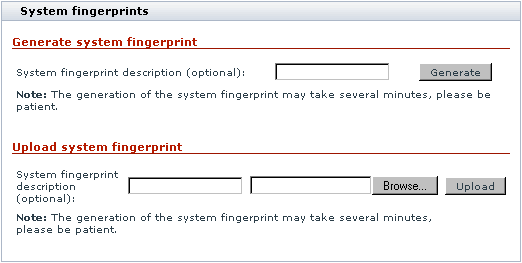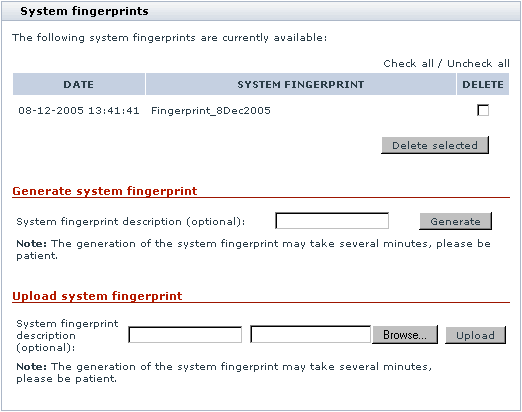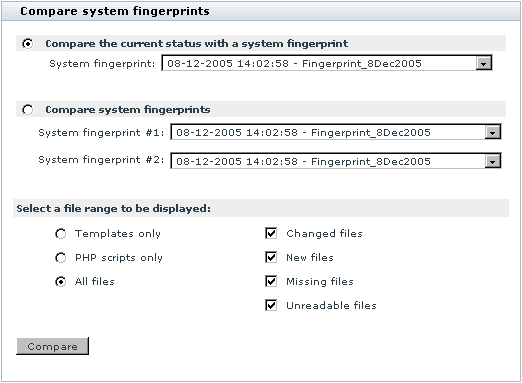X-Cart:System Fingerprints
Contents
MD5 checksums
X-Cart uses MD5 (Message-Digest algorithm 5) for data integrity control. It provides a tool which allows you to create lists of MD5 checksums of all the files in X-Cart installation directory and to compare checksum lists generated at different periods of time to verify the integrity of X-Cart files.
In X-Cart, a list of MD5 checksums of all the files in the system is called a system fingerprint. The first system fingerprint in your store is generated automatically at the time of X-Cart installation. This system fingerprint reflects the original unmodified state of the system. Later, you can get X-Cart to generate more system fingerprints.
Any system fingerprint can be compared with the current state of the store or with any other fingerprint. Comparing fingerprints allows X-Cart to detect any changes in /xcart directory. As a result of comparing fingerprints, you get a list of files which have been modified, added or lost (removed from the system or renamed so they cannot be identified).
Generating system fingerprints
To get X-Cart to generate a system fingerprint:
1. Open the 'System fingerprints' section of X-Cart Admin area. 2. Go to the 'Summary' section (Administration menu->Summary). 3. In the 'Summary' section menu, click the link System fingerprints.
You should see a dialog box titled 'System fingerprints':
4. (Optional) In the 'Generate system fingerprint' subsection of the 'System fingerprints' dialog box, enter a description for the system fingerprint you are going to create. 5. Click the Generate button. X-Cart should launch the generation of the fingerprint. The process may take as long as several minutes. As soon as the fingerprint gets generated, you should see an Information box with a confirmation message.
The fingerprint should be added to the list of available system fingerprints:
Deleting system fingerprints
System fingerprints which you no longer need can be deleted directly from the 'System fingerprints' section of X-Cart Admin area.
To delete a system fingerprint:
1. Open the 'System fingerprints' section of X-Cart Admin area.
2. Go to the 'Summary' section (Administration menu->Summary). 3. In the 'Summary' section menu, click the link System fingerprints.
You should see a list of available system fingerprints in the 'System fingerprints' dialog box.
4. Select the DELETE check boxes opposite the system fingerprints that you wish to delete. 5. Click the Delete selected button below the list. The selected fingerprints should be removed. You should see an Information box with a confirmation message.
Uploading system fingerprints
X-Cart saves generated system fingerprints to the directory /xcart/var/log (a system fingerprint filename looks something like md5_1139908092log.php). If you do not wish to permanently keep system fingerprints in the directory /xcart/var/log, but wish to be able to use them in the future, you may want to move your fingerprint files to some place else - for example, you can download them to your local computer. Later, when you need to compare a downloaded system fingerprint with the current state of your store or with another system fingerprint, you will only need to upload this system fingerprint back onto X-Cart server so it becomes available in the directory /xcart/var/log. This can be done directly from the 'System fingerprints' section of X-Cart Admin area.
To upload a system fingerprint to the directory /xcart/var/log:
1. Open the 'System fingerprints' section of X-Cart Admin area:
2. Go to the 'Summary' section (Administration menu->Summary). 3. In the 'Summary' section menu, click the link System fingerprints.
You should see a dialog box titled 'System fingerprints'.
4. Scroll down to the 'Upload system fingerprint' subsection of the 'System fingerprints' dialog box. 5. (Optional) Use the 'System fingerprint description' field in this subsection to enter a description for the system fingerprint you are going to upload. 6. Click the Browse button and use the 'File Upload' window to locate the necessary system fingerprint file. Select the file. 7. When the filename of the selected fingerprint appears in the appropriate field in the 'System fingerprints' dialog box, click the Upload button. The fingerprint file should be uploaded to the directory /xcart/var/log.
As soon as the uploaded fingerprint appears in the list of available fingerprints in the 'System fingerprints' dialog box, you can use it as any other system fingerprint stored in the directory /xcart/var/log.
Comparing system fingerprints
At any moment, you can compare any existing system fingerprint with the current state of your store. If you have more than one system fingerprints, you can also compare them with one another.
To compare fingerprints:
1. Open the 'System fingerprints' section of X-Cart Admin area:
2. Go to the 'Summary' section (Administration menu->Summary). 3. In the 'Summary' section menu, click the link System fingerprints.
4. In the 'System fingerprints' section menu, click the link Compare system fingerprints. You should see a dialog box titled ' Compare system fingerprints':
5. Select whether you wish to compare the current status with a system fingerprint or to compare two system fingerprints (select the appropriate radio button). 6. Use the 'System fingerprint' drop-down box(es) to select the system fingerprint(s) that will be used for comparing. 7. Select a file range that you wish to be displayed in the comparison results:
- Templates only / PHP scripts only / All files;
- Changed files / New files / Missing files / Unreadable files.
8. Click the Compare button.
X-Cart should perform the comparison and output the results in the 'Comparison results' form below.


